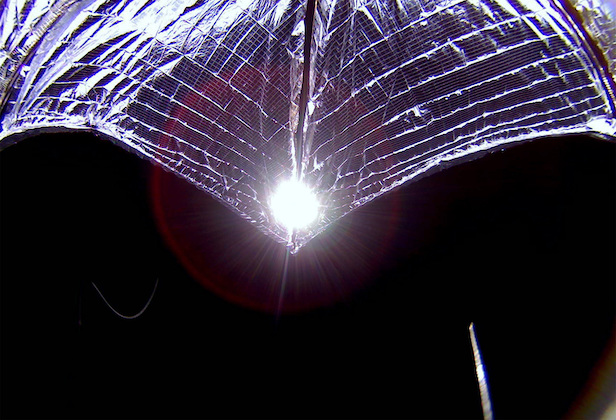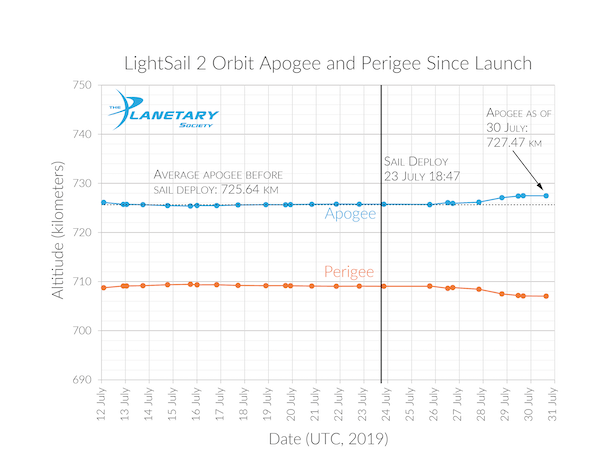LightSail 2 has successfully proven that sunlight can power propulsion
This demonstration is the first time ever that a spacecraft has used solar sailing for propulsion in Earth orbit

The sail is almost fully deployed in this image and appears warped near the edges due to the spacecraft’s 185-degree fisheye camera lens. Image credit: The Planetary Society
Years of computer simulations. Countless ground tests. They’ve all led up to now. The Planetary Society’s crowdfunded LightSail 2 spacecraft is successfully raising its orbit solely on the power of sunlight.
Since unfurling the spacecraft’s silver solar sail last week, mission managers have been optimising the way the spacecraft orients itself during solar sailing. After a few tweaks, LightSail 2 began raising its orbit around the Earth. In the past four days, the spacecraft has raised its orbital high point, or apogee, by about two kilometres (1.2 miles). The perigee, or low point of its orbit, has dropped by a similar amount, which is consistent with pre-flight expectations for the effects of atmospheric drag on the spacecraft. The mission team has confirmed the apogee increase can only be attributed to solar sailing, meaning LightSail 2 has successfully completed its primary goal of demonstrating flight by light for CubeSats.
“We’re thrilled to announce mission success for LightSail 2,” says LightSail program manager and Planetary Society chief scientist Bruce Betts. “Our criteria was to demonstrate controlled solar sailing in a CubeSat by changing the spacecraft’s orbit using only the light pressure of the Sun, something that’s never been done before. I’m enormously proud of this team. It’s been a long road and we did it.”
The milestone makes LightSail 2 the first spacecraft to use solar sailing for propulsion in Earth orbit, the first small spacecraft to demonstrate solar sailing, and just the second-ever solar sail spacecraft to successfully fly, following Japan’s IKAROS, which launched in 2010. LightSail 2 is also the first crowdfunded spacecraft to successfully demonstrate a new form of propulsion.
“For The Planetary Society, this moment has been decades in the making,” says Planetary Society CEO Bill Nye. “Carl Sagan talked about solar sailing when I was in his class in 1977. But the idea goes back at least to 1607, when Johannes Kepler noticed that comet tails must be created by energy from the Sun. The LightSail 2 mission is a game-changer for spaceflight and advancing space exploration.”
On 29 July 2019, LightSail 2 sent home a new full-resolution image captured by its camera during solar sail deployment. The perspective is opposite to the previous week’s full-resolution image and shows the sail more fully deployed. LightSail 2’s aluminised Mylar sail shines against the blackness of space, with the Sun peeking through near a sail boom.
The mission team will continue raising LightSail 2’s orbit for roughly a month, until the perigee decreases to the point where atmospheric drag overcomes the thrust from solar sailing. During the orbit-raising period, the team will continue optimising the performance of the solar sail.
“We’ve been working since sail deployment to refine the way the spacecraft tracks the Sun,” says LightSail 2 project manager Dave Spencer. “The team has done a great job getting us to the point where we can declare mission success. Moving ahead, we’re going to continue working to tune the sail control performance and see how much we can raise apogee over time.”

This chart shows LightSail 2’s orbit apogee and perigee since launch. From 26 July to 30 July 2019, the spacecraft raised its orbital high point, or apogee, by about two kilometres (1.2 miles). Image credit: The Planetary Society/Data provided by NXTRAC
One such refinement involves LightSail 2’s single momentum wheel, which rotates the spacecraft broadside and then edge-on to the Sun each orbit to turn the thrust from solar sailing on and off. Momentum wheels can “saturate,” hitting predefined speed limits, after which they are no longer effective at rotating the spacecraft. Most spacecraft use chemical thrusters to desaturate momentum wheels; LightSail 2 relies on electromagnetic torque rods, which orient the spacecraft by pushing against Earth’s magnetic field.
LightSail 2’s momentum wheel currently reaches its saturation limit a couple of times per day, and desaturating the wheel temporarily takes the spacecraft out of its proper orientation for solar sailing. The mission team already applied a software update that increased the time between saturation events, and is also working to automate the desaturation process. Both refinements should result in improved solar sailing performance.
After LightSail 2’s month-long orbit raising phase, the spacecraft will begin to deorbit, eventually reentering the atmosphere in roughly a year. The aluminised Mylar sail, about the size of a boxing ring, may currently be visible for some observers at dusk and dawn. The Planetary Society’s mission control dashboard shows upcoming passes based on user location, and includes a link to a page that highlights passes when the sail is more likely to be visible.
Roughly 50,000 Planetary Society members and private citizens from more than 100 countries, as well as foundations and corporate partners, donated to the LightSail 2 mission, which cost £5.8 million ($7 million) from 2009 through March 2019.
“LightSail 2 proves the power of public support,” says Planetary Society COO Jennifer Vaughn. “This moment could mark a paradigm shift that opens up space exploration to more players. It amazes me that 50,000 people came together to fly a solar sail. Imagine if that number became 500,000 or five million. It’s a thrilling concept.”
The Planetary Society shares LightSail program data with other organisations so that solar sail technology can be applied to future space exploration missions. The Society presented initial LightSail 2 results this week at the fifth International Symposium on Solar Sailing in Aachen, Germany. Results are also being shared with NASA’s NEA Scout mission, which is launching a solar sail-powered CubeSat to visit a near-Earth asteroid as early as next year.
LightSail 2 is one of several Planetary Society science and technology projects that aim to advance space science and exploration. Earlier this month, NASA chose PlanetVac, a Society-funded technology built by Honeybee Robotics that simplifies the process of collecting samples from other worlds, to fly to the Moon as part of the agency’s Commercial Lunar Payload Services (CLPS) program.
The LightSail program began in 2009 under the direction of Planetary Society co-founder Louis Friedman, following the launch of Cosmos 1, the world’s first solar sail that did not reach orbit. Friedman and Society co-founders Carl Sagan and Bruce Murray championed the idea of solar sailing more than four decades ago with a proposed solar sail mission to Halley’s Comet.
Keep up to date with the latest news in All About Space – available every month for just £4.99. Alternatively you can subscribe here for a fraction of the price!




